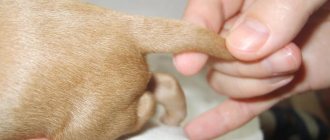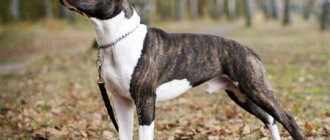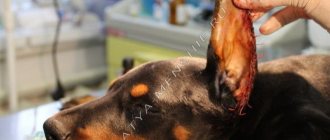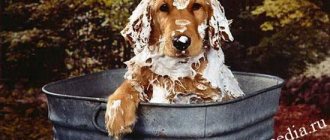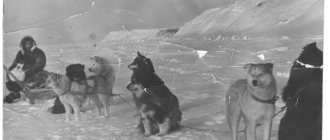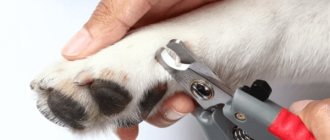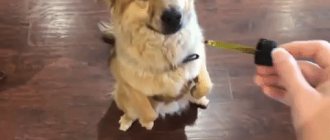The cosmetic procedure of tail docking is now considered blasphemous. Amputation is carried out only to maintain acceptable conformation for exhibitions and breed competitions. But, according to the European Convention for the Protection of Pet Animals, judges are obliged to accept and evaluate equally competitors with a natural tail shape and a docked one.
What is tail docking
Tail docking or tail amputation is an operation during which the veterinarian removes 2/3 (or another length, depending on the standard requirements) of the dog’s tail. The procedure is ancient, it has existed since domestic dogs appeared. Amputation is performed in two ways.
- Anesthesia is administered by inhalation (alcoholoform, a vagolytic to reduce salivation and an antipsychotic). Artificial tracheal ventilation (intubation) is created for dogs with a short muzzle to avoid the tongue retracting into the pharynx and stopping air from entering the lungs. Then the tail is shaved (if the owner has not done this before), the skin is pulled back to the base, and the required length is cut between the vertebrae with a sharp scalpel or scissors. The skin is pulled back onto the stump, sutured, and treated with an antibiotic solution and antiseptic. After which a bandage is applied.
- The second option for the procedure is long, uncomfortable for the pet, but does not require the use of anesthesia . In the right place, the tail is tied with a tourniquet for 5-7 days. The blood flow stops, the tip dries out and falls off. This may cause the puppy to experience severe pain. The older the dog, the more difficult the procedure is.
Exterior
The body of the Alabai is slightly elongated, but proportional. Despite its rather massive build, the dog should not appear clumsy. The muscles are dense, voluminous, well developed, but the relief is not clearly expressed. Elastic joints allow a dog with a powerful physique to maintain the natural flexibility characteristic of the breed.
The head of the Central Asian Shepherd is symmetrical, the muzzle is short, close to rectangular in shape, and practically does not taper towards the nose. The transition to the muzzle from the forehead is moderately pronounced.
The nose is wide, straight, black, with a slight hooked nose. If the color is white or fawn, a lightened nose is allowed.
The dog has small, relatively deep-set, oval-shaped eyes of brown shades. The look is attentive, wary.
The lips are powerful, thick, the upper ones completely cover the bulky lower jaw. The teeth are white, tightly adjacent to each other. In a complete set - 42, however, broken or knocked out incisors do not interfere with the correct bite and do not affect the dog’s assessment. The canines are strong and widely spaced. Scissor bite.
The neck is heavy, of medium length.
The limbs are straight and parallel.
The back is strong, wide, a slight deflection is possible.
The croup is slightly sloping, with well-developed muscles.
The tail of the Alabaev is dense at the base, set high. When intact, sickle-shaped or curled into a ring in the last third. Inherited bobtail is also common.
The skin of dogs is quite elastic and mobile, but at the same time quite thick. The suspension on the neck protects the throat from injury during fights and fights with predators, but it should not be too pronounced.
Some breeders adhere to classifications related to the origin of the animal and its body type:
- Mountain type. These are strong, stocky dogs with long hair, characteristic of animals in mountainous regions.
- Steppe type. Such animals also have long hair, but are faster and more agile, with free movements.
- Oasis-desert type. In terms of physique and movements, it is almost no different from the previous type, but has short hair.
Dimensions: height at withers and weight
The height of males has no upper limit and often reaches 90 cm, but should not be less than 70 cm. For females, the lower limit is 65 cm.
Alabai is capable of gaining up to 60–70 kg of weight. The record weight was recorded for a male dog from the Stavropol Territory - about 130 kg.
Color
Almost all colors are acceptable in the breed: black, white, gray, fawn, piebald, speckled, brindle. Exceptions are liver and blue in any variations. The reason for this is evidence of admixture of German Shepherd or Great Dane blood. The ban on liver coloring is not so logical, since brown dogs are regularly found in the original habitats of the Alabais. There is a so-called wolf color of a brown or zone-red hue.
Wool
The Alabai's coat is very thick, with a developed undercoat. Both short-haired individuals with close-lying hair and individuals with hair up to 10 cm long are allowed. In the spring, representatives of this breed shed profusely. To make the coat look attractive, the animal must be brushed frequently.
Cupping
Alabai ears are medium-sized, hanging, triangular in shape. Even in early childhood, they are most often docked short. As a rule, male dogs undergo the operation. It enhances the impression of a wide, rounded head at the back of the head. For docked dogs that participate in exhibitions, symmetrical cuts are important.
There is also a slight docking of the tail in Alabais without reducing its functional purpose. In puppies of aboriginal breeds, up to 10 days of age, the nerve endings in the ears are practically inactive, and the vertebrae are soft, like cartilage.
What is it for
The first reason the Ancient Romans docked dogs' tails was for safety. The smaller the body area of a fighting dog, the more difficult it is to inflict wounds during a fight. So not only the tails of the gladiator dogs were cut, but also the ears.
Peasants in the Middle Ages performed docking on herding dogs. People believed that this procedure would protect against rabies. A little later, in the 18th century, in England, bushy tails were cut for shepherd dogs guarding herds. The shepherds believed that this would make it easier for the dogs to fight the wolves. In addition, they did not want to deal with hygiene procedures, pulling out garbage and branches from the wool.
Hunting dogs had their tails cut off to prevent them from clinging to trees and bushes while chasing wild animals. The procedure was especially useful for burrow hunters who encountered a predator underground in complete darkness.
But it wasn’t just the reasons for preserving the pet’s health that worried the breeders. Since the 18th century, there was a law in Europe according to which a tax was charged for any purebred non-working dog. A docked tail was a sign that the dog belonged to a police or security unit.
Now almost all of Europe has banned the amputation of tails for cosmetic purposes. The law allows circumcision only for service dogs that are registered with police, border, and rescue services.
In the CIS countries the situation is different; docking is still considered legal if required by the breed standard. The final decision still remains with the owner.
Standards for purebred CAO
The Central Asian Shepherd belongs to the Molossian group of dog breeds of Asian origin. This is a strong, proportionally built dog.
Adult dog: characteristics of a male and female
Males look more massive and courageous, have more muscular and more clearly defined withers. They are distinguished by their calm behavior and prefer to be in one elevated place, carefully looking around the surroundings.
Bitches, as a rule, are smaller, lighter, have a more elongated body and a smaller head. They prefer to control the situation by moving around the perimeter of their territory.
Puppy
It is better to adopt an Alabai puppy at the age of one and a half to two months.
The puppy grows relatively quickly and at the age of nine months has the characteristics of an adult dog. In the future, he becomes stronger and more muscular. Dogs of this breed mature fully by two to three years.
At what age is it best to have surgery?
The best age for cupping is 3-10 days after birth. It is believed that during this period puppies are less sensitive to pain, and the cartilaginous joint tissues have not had time to ossify. Therefore, children are operated on without anesthesia, without applying a tourniquet. The main rule is healing without licking the mother; the breeder must monitor this.
Amputation is often performed at the age of 10-20 days . Then local or general anesthesia is required. The dog is placed on its stomach, its paws and muzzle are fixed, and part of the tail is removed. If a dog is operated on at 3-4 weeks, then a tourniquet must be applied to the tail.
Evidence from experts suggests that puppies have an increased sensitivity to pain and the “humaneness” of tail trimming in childhood is not confirmed by anything. During amputation, the integrity of muscles, tendons, bone and cartilage joints is disrupted. In this case, more than 14 sensory nerves are affected.
Before the operation, laboratory tests are carried out: blood tests, ultrasound, and less often, x-rays. This is necessary to exclude contraindications to drugs and anesthesia components. Before the procedure, it is recommended to prepare your pet:
- Cleanse from helminths within 2 weeks;
- Do not feed your pet for 12 hours, but increase the drinking regime;
- Every hour before surgery, measure the temperature (maximum - 39 degrees, minimum - 37);
- Select the amputation site (the breed standard will help with this), shave the tail in the selected area, and disinfect it with an aqueous antiseptic (Chlorhexidine).
A categorical contraindication is congenital physiological abnormalities in the puppy. The procedure is not performed on lethargic, sick pets with unusual or inflamed discharge.
Deviations from the standard
Serious disadvantages include: significant deviations in the exterior: lightness or looseness of build, long legs, narrow head, long muzzle, high-set ears, close-set eyes, curly hair, tail curled into a tight ring, height below the standard by 2 cm or more . Disqualifying character deviations are: timidity, cholericism, uncontrollable malice.
Albinos
Albinism in the Central Asian Shepherd is considered a disease. If the color is white, be sure to check the dark nose to prevent such individuals from being bred.
Alabai with blue eyes
Blue or multi-colored eyes are also disqualifying faults for the breed.
Undocked dog
When judged, docked and undocked animals are of equal value; undocked animals are not a deviation.
Alabai is a proud, difficult, but one of the most unique dog breeds. With proper training, your pet will grow into a loyal friend and devoted protector, friendly to children. Significant advantages of the breed are its unpretentious maintenance, good health and resistance to temperature changes. The disadvantages include an increased need for movement and difficulty in learning, as well as the impossibility of keeping them in an apartment.
Is it possible to dock the tail of an adult dog?
The main problem when operating on adult dogs is complications after anesthesia. Not all animals over 2 years of age respond positively to anesthesia. The heart is especially defenseless against the action of anesthetic vapors.
Any dog owner will say that “the game is not worth the candle.” Because of a simple whim, a person can lose a pet. Although veterinarians take on work of any complexity, issuing large checks for the procedure. In any case, it is better not to take risks and leave the pet’s tail in its natural form.
Advantages and disadvantages
Advantages
Here we can only say one thing - if there are medical indications for cupping, then the procedure is necessary and useful. What could be the reason? Inflammation, suppuration, necrotic processes that are not amenable to drug treatment.
Only in these cases can cupping be justified and be able to bring real benefits . This is a last resort and the only advantage of ear cropping. After all, only this procedure in some cases can save the life of a pet.
Flaws
The disadvantages include:
- After ear cropping, all routes to international exhibitions will be closed for your pet.
- The post-traumatic stress that the brace experiences, as well as the difficult postoperative period, will only bring her suffering, without any practical benefit.
- Distortion of facial expressions. After all, any dog with raised ears always looks aggressive and this prevents it from finding a common language with its relatives.
In most civilized countries, ear cropping is considered cruelty to animals and entails liability..
An exception is a procedure performed for medical reasons (injury, inflammation, etc.).
Possible complications after surgery
Even if the operation was performed under anesthesia, the pain will not go away. Babies will squeak and cry. Some owners even complain that the puppy has lost his voice after docking his tail. This can happen if the dog has damaged ligaments from screaming.
Another problem is the occurrence of suppuration. If the amputation was carried out with non-sterile instruments or an antiseptic was not used to treat the sutures, then inflammation cannot be avoided. Difficult healing is also observed with active licking of wounds. The mother will instinctively treat the puppies, which should not be allowed.
With prolonged healing, scars can form, spoiling the appearance of the ponytail.
Scientists have proven the negative impact of tail docking on the general condition of the dog’s nervous system and sensitivity:
- Removing the tail vertebrae can impair a dog's motor skills;
- Due to the removal of the “counterweight,” the load on the pelvic region and hind limbs is incorrectly distributed, which leads to deformation of the paws and muscle atrophy;
- Dogs with docked tails are more likely to develop intervertebral hernias;
- Due to the operation, dogs may suffer from diseases of the urinary system;
- The absence of a tail in a dog is like the absence of a tongue in a person; relatives are less likely to come into contact with such a pet, because a bob-tailed dog is more difficult to understand;
- Statistically, pets with docked tails are more aggressive.
Experiments on rats have proven that overall sensitivity in animals with amputated tails is reduced.
Toy terrier ear correction
In order to install the ears of a puppy, it is recommended to use the following technique:
- Cut two pieces from the patch, repeating the inner shape of the ears;
- Place a tire (plastic strip, etc.) between the cut out pieces and stick the resulting mechanism onto the ears from the inside;
- This procedure is carried out at three months of age, and the structure is kept on the ears for at least two months;
- To prevent the puppy from getting nervous and trying to free his ears, in the first days you need to constantly play with him in order to distract him from the unusual structure on his head.
In order for the ear cartilages to be well strengthened, you need to provide your pet with proper and nutritious nutrition. It must include foods containing large amounts of calcium.
If the puppy eats ready-made food, it should be fortified with calcium. You can also give him additional vitamin and mineral complexes.
Remember! Currently, in our country, docking the tail and ears of dogs is not a prerequisite for participation in exhibitions.
The price of the procedure at the vet. clinics
The price of the procedure will depend on the method of docking, the age of the animal, and the location of the operation. Calling a veterinarian to your home is always more expensive than visiting a clinic.
On average, docking costs owners 700-1200 rubles, but depending on the prestige and location of the veterinary hospital, the price may increase or decrease.
To carry out the operation, it is better to choose a veterinarian with experience and good reviews. Cheap is not always high quality.
